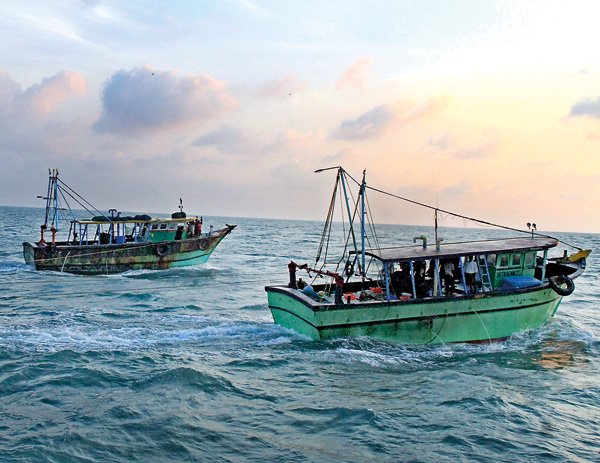The sea around the Palk Bay and the Gulf of Mannar has been used by the fishermen of Tamil Nadu and Sri Lanka until a legally binding agreement, the IMBL (The International Maritime Boundary Line) was signed separating the territorial waters.
The fishermen in the Indian side of the IMBL used bottom-trawling to boost production with their upgraded steel hulled fishing vessels.
When stocks depleted, they crossed over to the Sri Lankan side of the IMBL rousing a conflict.
Issue with Bottom Trawling
Source: Penelope Bagieu’s Blog
Bottom Trawling is a fishing practice which drags trawlers or weighted-fishing nets across the seafloor. Bottom trawlers bulldoze or mow down juvenile fishes, exhausting the ocean’s resources and affecting marine conservation.
The marine environment is disturbed affecting corals and the growth of plankton following the abrupt scraping of the sea floor. This results in “habitat degradation”.
Bottom trawling was started by the fishermen of Tamil Nadu in the Palk Bay area. They ventured 2-3 nautical miles off the Lankan coast into the deep Lankan territorial waters and continued poaching underwater at the peak of the civil war.
Fishing is the cornerstone of livelihood in northern Sri Lanka. With the deleterious impacts on the marine ecosystem, “habitat degradation” can pose a threat to the human security.
The Sri Lankan navy boats have been vigilantly patrolling the IMBL, capturing Indian trawlers and fishermen indulging in IUU (Illegal, Unreported and Unregulated) fishing.
You can Also Read: Ama (Sea) Divers Dying A Slow Death
Deep Sea Fishing: Alternative to Bottom Trawlers
With the Sri Lankan legislation banning bottom trawling, deep sea fishing mandate has gained momentum. This mode of fishing requires boats that are specifically designed for accessibility in the deeper parts of the ocean.
The depth of water should be at least 30 meters for the area to be considered a deep sea fishing territory.
The obligations of the Deep Sea Fishing Plan are listed below:
– About 2000 trawler boats are to be replaced by 500 deep-sea fishing vessels in the coming three years (2017-2020).
– Each vessel will be equipped with tuna long-lining with a unit worth of Rs 80 lakh. Bearing this disbursement, the trawl owners will have to pay Rs 8 lakh in advance and Rs 16 lakh through a loan from the Pandyan Graman bank. The balance will be mutually shared by the State (Tamil Nadu)and Central Government through subsidy.
– The government has outlined a plan for establishing a 500-acre fishing industrial estate in Nagapattinam.
– The beneficiaries of the plan should possess navigable trawl vessels of around 12m in length that has been registered. These are to be scrapped or disposed of outside the Palk Bay area.
– The deep-sea fishing vessels cannot operate in the Palk Bay area.
– The vessels will be moored at Mookaiyur, south of the Palk Bay in the Gulf of Mannar.
– Preference would be given to fishermen who have had their boats apprehended or damaged in Sri Lanka. The beneficiaries of the plan cannot sell their boats for five years after obtaining them.
Too many concerns that need to be redressed:
– Lack of clarity on the oceanic stocks available in the adjoining waters of the Bay of Bengal and Gulf of Manner tipping towards the uncertainty of economic viability.
– The high operational costs of deep sea fishing and the loan repayment schedule raise a substantial concern.
– With the insistence of skill upgrade, the fate of opportunities for the existing fish trawlers remains copiously shunned.
– The limited skills and interest of Palk Bay fishers to one-day fishing and trawling raise a cause of concern.
The Need for a Multi-Dimensional Approach in this hour
The Tamil Nadu government has to ensure that the remaining trawler boats are not upgraded in size or engine horsepower as many continue to fuel engine capacities secretly beyond limits. The monitoring and surveillance have to be increased for the process of decommissioning.
Schemes such as seaweed farming and sea-cage farming have to be advocated in order to discourage fisherman from any sort of IUU fishing activity.
A comprehensive plan is yet to be made that can benefit all the stakeholders in the fisheries.
(Source from Google Images )
More Recommendations:
http://edtimes.in/2013/12/somethings-jelly-fishy/





































Interesting!!
Thanks for your gracious comment.